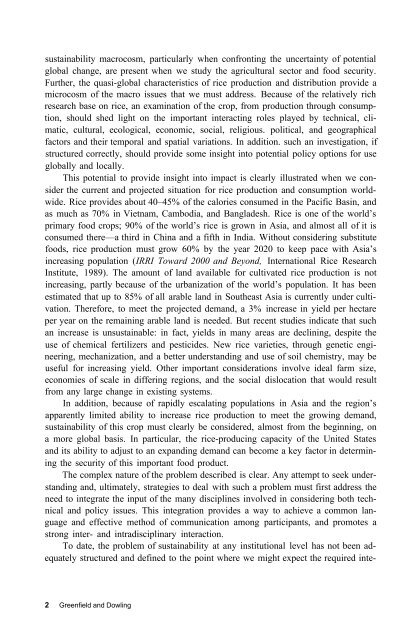Sustainability of rice in the global food system - IRRI books
Sustainability of rice in the global food system - IRRI books
Sustainability of rice in the global food system - IRRI books
You also want an ePaper? Increase the reach of your titles
YUMPU automatically turns print PDFs into web optimized ePapers that Google loves.
susta<strong>in</strong>ability macrocosm, particularly when confront<strong>in</strong>g <strong>the</strong> uncerta<strong>in</strong>ty <strong>of</strong> potential<br />
<strong>global</strong> change, are present when we study <strong>the</strong> agricultural sector and <strong>food</strong> security.<br />
Fur<strong>the</strong>r, <strong>the</strong> quasi-<strong>global</strong> characteristics <strong>of</strong> <strong>rice</strong> production and distribution provide a<br />
microcosm <strong>of</strong> <strong>the</strong> macro issues that we must address. Because <strong>of</strong> <strong>the</strong> relatively rich<br />
research base on <strong>rice</strong>, an exam<strong>in</strong>ation <strong>of</strong> <strong>the</strong> crop, from production through consumption,<br />
should shed light on <strong>the</strong> important <strong>in</strong>teract<strong>in</strong>g roles played by technical, climatic,<br />
cultural, ecological, economic, social, religious. political, and geographical<br />
factors and <strong>the</strong>ir temporal and spatial variations. In addition. such an <strong>in</strong>vestigation, if<br />
structured correctly, should provide some <strong>in</strong>sight <strong>in</strong>to potential policy options for use<br />
<strong>global</strong>ly and locally.<br />
This potential to provide <strong>in</strong>sight <strong>in</strong>to impact is clearly illustrated when we consider<br />
<strong>the</strong> current and projected situation for <strong>rice</strong> production and consumption worldwide.<br />
Rice provides about 40–45% <strong>of</strong> <strong>the</strong> calories consumed <strong>in</strong> <strong>the</strong> Pacific Bas<strong>in</strong>, and<br />
as much as 70% <strong>in</strong> Vietnam, Cambodia, and Bangladesh. Rice is one <strong>of</strong> <strong>the</strong> world’s<br />
primary <strong>food</strong> crops; 90% <strong>of</strong> <strong>the</strong> world’s <strong>rice</strong> is grown <strong>in</strong> Asia, and almost all <strong>of</strong> it is<br />
consumed <strong>the</strong>re—a third <strong>in</strong> Ch<strong>in</strong>a and a fifth <strong>in</strong> India. Without consider<strong>in</strong>g substitute<br />
<strong>food</strong>s, <strong>rice</strong> production must grow 60% by <strong>the</strong> year 2020 to keep pace with Asia’s<br />
<strong>in</strong>creas<strong>in</strong>g population ( <strong>IRRI</strong> Toward 2000 and Beyond, International Rice Research<br />
Institute, 1989). The amount <strong>of</strong> land available for cultivated <strong>rice</strong> production is not<br />
<strong>in</strong>creas<strong>in</strong>g, partly because <strong>of</strong> <strong>the</strong> urbanization <strong>of</strong> <strong>the</strong> world’s population. It has been<br />
estimated that up to 85% <strong>of</strong> all arable land <strong>in</strong> Sou<strong>the</strong>ast Asia is currently under cultivation.<br />
Therefore, to meet <strong>the</strong> projected demand, a 3% <strong>in</strong>crease <strong>in</strong> yield per hectare<br />
per year on <strong>the</strong> rema<strong>in</strong><strong>in</strong>g arable land is needed. But recent studies <strong>in</strong>dicate that such<br />
an <strong>in</strong>crease is unsusta<strong>in</strong>able: <strong>in</strong> fact, yields <strong>in</strong> many areas are decl<strong>in</strong><strong>in</strong>g, despite <strong>the</strong><br />
use <strong>of</strong> chemical fertilizers and pesticides. New <strong>rice</strong> varieties, through genetic eng<strong>in</strong>eer<strong>in</strong>g,<br />
mechanization, and a better understand<strong>in</strong>g and use <strong>of</strong> soil chemistry, may be<br />
useful for <strong>in</strong>creas<strong>in</strong>g yield. O<strong>the</strong>r important considerations <strong>in</strong>volve ideal farm size,<br />
economies <strong>of</strong> scale <strong>in</strong> differ<strong>in</strong>g regions, and <strong>the</strong> social dislocation that would result<br />
from any large change <strong>in</strong> exist<strong>in</strong>g <strong>system</strong>s.<br />
In addition, because <strong>of</strong> rapidly escalat<strong>in</strong>g populations <strong>in</strong> Asia and <strong>the</strong> region’s<br />
apparently limited ability to <strong>in</strong>crease <strong>rice</strong> production to meet <strong>the</strong> grow<strong>in</strong>g demand,<br />
susta<strong>in</strong>ability <strong>of</strong> this crop must clearly be considered, almost from <strong>the</strong> beg<strong>in</strong>n<strong>in</strong>g, on<br />
a more <strong>global</strong> basis. In particular, <strong>the</strong> <strong>rice</strong>-produc<strong>in</strong>g capacity <strong>of</strong> <strong>the</strong> United States<br />
and its ability to adjust to an expand<strong>in</strong>g demand can become a key factor <strong>in</strong> determ<strong>in</strong><strong>in</strong>g<br />
<strong>the</strong> security <strong>of</strong> this important <strong>food</strong> product.<br />
The complex nature <strong>of</strong> <strong>the</strong> problem described is clear. Any attempt to seek understand<strong>in</strong>g<br />
and, ultimately, strategies to deal with such a problem must first address <strong>the</strong><br />
need to <strong>in</strong>tegrate <strong>the</strong> <strong>in</strong>put <strong>of</strong> <strong>the</strong> many discipl<strong>in</strong>es <strong>in</strong>volved <strong>in</strong> consider<strong>in</strong>g both technical<br />
and policy issues. This <strong>in</strong>tegration provides a way to achieve a common language<br />
and effective method <strong>of</strong> communication among participants, and promotes a<br />
strong <strong>in</strong>ter- and <strong>in</strong>tradiscipl<strong>in</strong>ary <strong>in</strong>teraction.<br />
To date, <strong>the</strong> problem <strong>of</strong> susta<strong>in</strong>ability at any <strong>in</strong>stitutional level has not been adequately<br />
structured and def<strong>in</strong>ed to <strong>the</strong> po<strong>in</strong>t where we might expect <strong>the</strong> required <strong>in</strong>te-<br />
2 Greenfield and Dowl<strong>in</strong>g

















